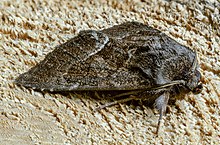
The pine beauty is a moth of the family Noctuidae. It is a common species of pine woods in Europe. The distribution area extends from Portugal to western Siberia, the Caucasus and Asia Minor. In the north it extends to the Arctic Circle, in the south it is found in Ceuta in Northern Africa in and southern Italy.
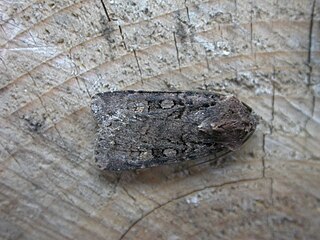
The garden dart is a moth of the family Noctuidae. It is distributed throughout much of the Palearctic. Temperate regions of Europe, Central Asia and North Asia, as well as the mountains of North Africa. Absent from polar regions, on Iceland and some Mediterranean islands, as well as in Macaronesia.

Eupsilia transversa, the satellite, is a moth of the family Noctuidae. The species was first described by Johann Siegfried Hufnagel in 1766. It is distributed throughout the Palearctic.
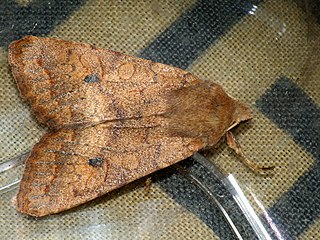
Agrochola circellaris, or The Brick, is a species of moth of the family Noctuidae. The species was first described by Johann Siegfried Hufnagel in 1766. It is distributed throughout most of Europe, Asia Minor and Armenia.

Apamea crenata, known as the clouded-bordered brindle, is a moth in the family Noctuidae. It is distributed throughout the Palearctic realm. In the North it crosses the Arctic Circle, in the Mediterranean it is found only in cool locations and mountains avoiding very hot areas. In the Alps, it rises to an altitude of about 2000 metres.

Apamea sordens, the rustic shoulder-knot or bordered apamea, is a moth of the family Noctuidae. The species was first described by Johann Siegfried Hufnagel in 1766. It is distributed throughout Europe, east across the Palearctic to Central Asia and to China and Japan. It also occurs in North America.

Mythimna albipuncta, the white-point, is a moth of the family Noctuidae. The species was first described by Michael Denis and Ignaz Schiffermüller in 1775. It is distributed throughout Europe and one subspecies is found in Tunisia. It is also found in Asia Minor, Armenia, and Iran, and the northeastern United States.

Orthosia incerta, the clouded drab, is a species of moth of the family Noctuidae, found in Europe and Asia. The occurrence of the species extends through all European countries through the Palearctic to the Russian Far East and Japan. It is absent from northern Fennoscandia and in the Alps it occurs up to 2000 m above sea level.

Caradrina morpheus, the mottled rustic, is a moth of the superfamily Noctuoidea. The species was first described by Johann Siegfried Hufnagel in 1766. It is found across the Palearctic from northern Europe to Siberia, Amur and Korea. Also in Armenia and Turkestan. It was accidentally introduced on both the east and west coasts of Canada and is so far reported in the east from New Brunswick to Ontario, and in the west from British Columbia.

Noctua interjecta, the least yellow underwing, is a species of moth of the family Noctuidae. It is found in Europe.
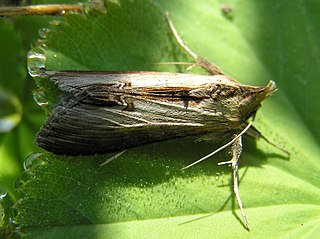
Cucullia asteris, or star-wort, is a moth of the family Noctuidae. The species was first described by Michael Denis and Ignaz Schiffermüller in 1775. It is found through the Palearctic including Japan.

Pyrrhia umbra, the bordered sallow, is a moth of the family Noctuidae. The species was first described by Johann Siegfried Hufnagel in 1766. It is found in all of Europe, east through Anatolia to Iran, Afghanistan, Pakistan and Nepal and through central Asia to Japan. In mountains it can be found up to elevations of 1,600 meters.

Mesapamea secalis, the common rustic, is a moth of the family Noctuidae. The species was first described by Carl Linnaeus in his 1758 10th edition of Systema Naturae. It is found in Europe, north-west Africa, Turkey and northern Iran.

Coranarta cordigera, the small dark yellow underwing, is a moth of the family Noctuidae. The species was first described by Carl Peter Thunberg in 1788. It can be found in parts of Europe, mainly in the north. In central and southern Europe it is only found in mountainous areas. In the Alps for instance, it is found up to elevations of 2,200 meters.

Agrotis vestigialis, the archer's dart, is a moth of the family Noctuidae. The species was first described by Johann Siegfried Hufnagel in 1766. It is found in most of the Palearctic realm from Ireland east, through to Russia, Siberia, the Altai Mountains and the Amur region, and is also present in the Mediterranean Basin. It is absent from the north of Finland and Norway.
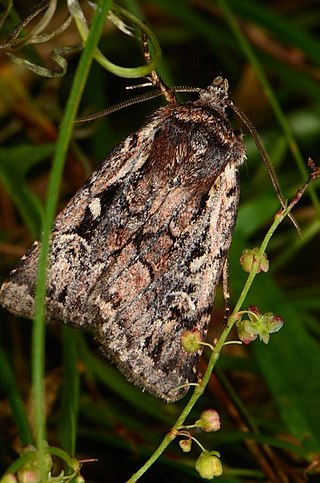
Xestia agathina, the heath rustic, is a moth of the family Noctuidae. It is found in western and central Europe and Morocco.

Agrochola litura, the brown-spot pinion, is a moth of the family Noctuidae. The species was first described by Carl Linnaeus in 1761. It is found in Europe and the Middle East. It is possibly also present in North Africa, but this is unclear because similar looking species Agrochola meridionalis is found there.

Lithophane ornitopus, the grey shoulder-knot, is a moth of the family Noctuidae. The species was first described by Johann Siegfried Hufnagel in 1766 and is found in most of the Palearctic realm from Ireland east to Siberia.

Lithophane furcifera, the conformist, is a moth of the family Noctuidae. The species was first described by Johann Siegfried Hufnagel in 1766. It is found from central Europe, east to the Black Sea region, the Caucasus and western Siberia. In the mountains, it is found up to elevations of 1,800 meters.

Eriopygodes imbecilla, the Silurian, is a moth of the family Noctuidae first described by Johan Christian Fabricius in 1794.
